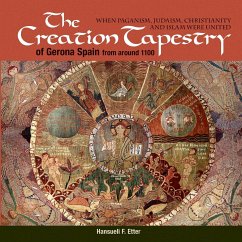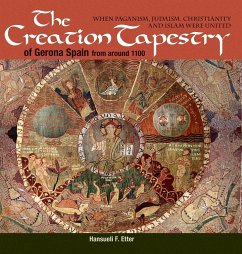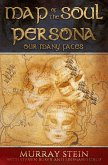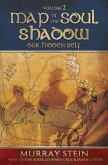Around the year 1100 a genius mind-woman or man-created an image, which has not lost its meaning even to this day. It was made by hundreds of busy hands as a colorful goblin most likely used originally for centuries as a canopy in the Romanesque Cathedral of Gerona, North east of Spain. The original tapestry showed all the signs of a mandala: a big circle surrounded by a square with a central symbol and many interesting details. What makes this mandala unique, is the fact that it unites pagan symbols in the form of nature gods (rivers, winds, the year), as well as the genesis of the Jewish Tora (the creation myth), the holy cross of Christianity held by the roman emperor Constantine the Great and according to Muslim tradition the tapestry as a whole and its mandala shape. In 1982, author Hansueli Etter visited the Cathedral of Gerona in Catalonia (Spain) as a tourist. There he met the Creation Tapestry for the first time. He hoped to find an answer to the following questions: why the Creation Tapestry fascinated him as well as thousands of annual visitors and why this medieval image still enthralls today, going far beyond an art-historical curiosity. After extensive studies he dared to reconstruct the missing parts at the bottom of the picture, since the basic concept is undoubtedly a mandala. The added images should fit sensibly into the essential statement of the Creation Tapestry. Nowadays a part at the bottom of the tapestry is missing, but the still visible iconographic details and the understanding of its meaning allowed a full reconstruction of the image. To discover the symbolic meaning of the rich iconography of the Creation Tapestry opens up an insight in the common background of all religions back to the roots of shamanism, which use mandalas in dance as well as in images. To create or meditate on mandalas is till today a healing process and affects the human psyche deeply. Mandalas enforce the tendencies to unite the opposites, which is so crucial in our time. Table of Contents -Personal Foreword -Preface -Introduction To The Tapestry -Description Of The Tapestry -The History Of The Tapestry -On The Use Of The Tapestry -The Meaning Of The Tapestry -Primordial Beginnings - The Male And Female Aspects Of God -The First Four Days Of Creation -Physics And Depth Psychology: Modern Approaches To Wholeness? -Everyday Life As Depicted In The Border Of The Tapestry -The Legend Of The Holy Cross -Suggestions For The Missing Sections Of The Tapestry -Bibliography
Hinweis: Dieser Artikel kann nur an eine deutsche Lieferadresse ausgeliefert werden.
Hinweis: Dieser Artikel kann nur an eine deutsche Lieferadresse ausgeliefert werden.








